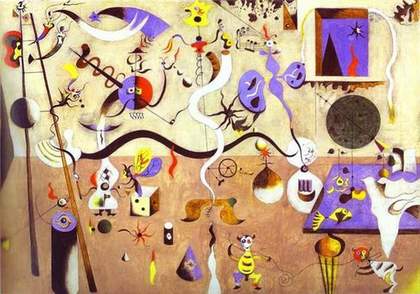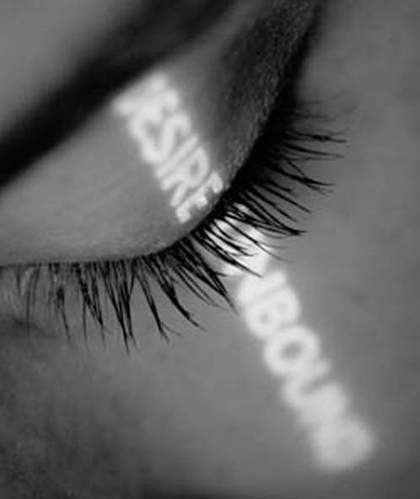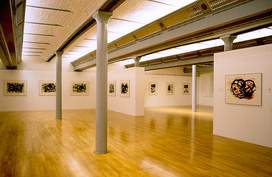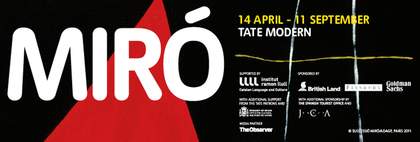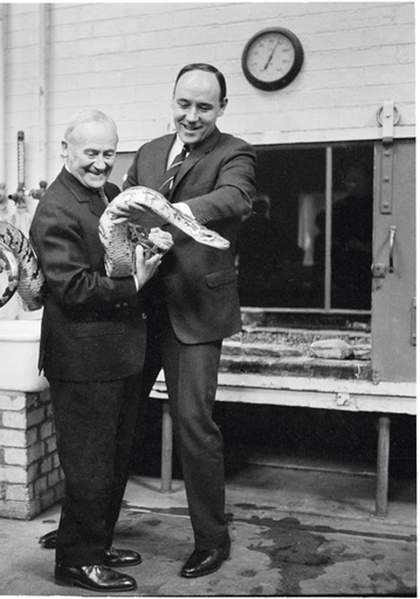
Joan Miró and Desmond Morris in the reptile house at London Zoo 1964, photographed by Lee Miller
Courtesy Desmond Morris © Lee Miller Archives
When I am asked to name the greatest artist of the twentieth century, I answer, without hesitation, Miró. But what about Picasso? Yes, he was a genius, but to me he seemed to be preoccupied with a magnificent dismembering of the nineteenth century, ratherthan creating a dramatically new language of art.
I had discovered Miró in the early 1940s, while I was still at school, and felt immediately drawn to his work. A few years later, when I had been conscripted into in the army, I contrived to make regular monthly visits to the exhibitions at the London Gallery in Brook Street, run by the Belgian Surrealist Edouard Mesens and funded by Roland Penrose. There I was able to come face to face with original works by Miró for the first time, and I was even more impressed by his extraordinary inventiveness and the boldness of his line. Mesens gave me my first London show in 1950, and I was delighted when he wrote to me saying: ‘Your neighbouring exhibitor will not be Jean Hélion; in Room A there will be a show of Joan Miró.’ To share an exhibition with him was really special for me and allowed me to study his revolutionary work more closely.
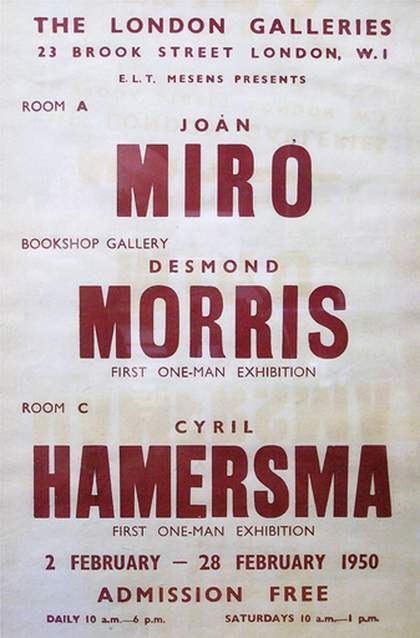
Poster for Joan Miró, Desmond Morris and Cyril Hamersma exhibition at ELT Mesen’s the London Gallery, February 1950
Courtesy Desmond Morris
Later in the 1950s I carried out an investigation into the remarkable picture-making abilities of a chimpanzee called Congo. His paintings were not random splashes, but visually controlled abstract compositions, and Roland arranged an exhibition of them at the ICA in London. He gave one of Congo’s paintings to his old friend ‘Don Pablo’, and when Miró heard that Picasso owned one, he wanted one too and came to see me in London. He stayed with Roland and his wife, the photographer Lee Miller, and Roland called me to say that, apart from acquiring a Congo painting, Miró was also fascinated by the possibility of encountering some of the London Zoo animals at close quarters. He asked, in particular, if he could meet ‘brightly coloured birds and creatures of the night’.
As I was a zoo curator at the time, I was able to make special arrangements for him to go behind the scenes. I fixed up details with the keepers and awaited his arrival. When the car drew up at the zoo gates, the figure who got out was of small stature and immaculately dressed in a quietly elegant suit. He looked more like a Spanish banker or diplomat than the creator of some of the wildest, most outrageous works of art of the century. His manner was courteous and correct. I was used to showing heads of state around the zoo, and this felt no different.
We went to the bird house where, to Miró’s joyful if somewhat alarmed surprise, I had a huge hornbill placed on his wrist. I had chosen this bird because the bright colouring around its eye could have been painted there by Miró’s hand. He gave me a nod that indicated he understood this. Lee took a splendid photograph of him feeding the hornbill, and we moved on to the nocturnal house. There I arranged for him to watch in close-up as a chameleon shot out its unbelievably long tongue, which had a sticky knob on the end, to catch a large insect. Miró’s response was that of an excited child, his eyes lighting up as the chameleon struck.
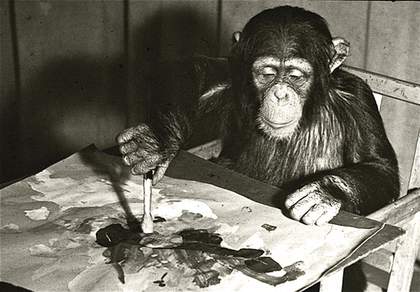
Congo the chimp painting at London Zoo, 1957
Courtesy Desmond Morris
When we moved to the reptile house and a small snake was brought out for him, there was an almost audible twinkle in his eyes. He was leaning forward to peer at the snake’s head when a keeper held up a dead mouse and the reptile struck at it with lightning speed. Miró jumped back as the snake’s head flashed past him, then laughed at the sheer beauty and ferocity of the action he had witnessed. He had been quoted as saying that, in a painting, a line should ‘strike like a knife’, and here was a snake doing just that.
I had saved the best for last. I remembered that in one of the earliest surviving drawings made by Miró, dating from 1908 when he was only fifteen, he had depicted a giant serpent that appeared to be trying to constrict itself. At some risk, bearing in mind his small stature, I had arranged for a huge python to be wrapped around his body, so that he could sense the enormous power of the animal as it settled its heavy bulk around his shoulders. At one point I thought that I had made a mistake and that Miró, who in 1964 was already in his seventies, would collapse under the weight of the (deliberately well-fed) snake. There was a brief struggle, and then success. He stood smiling triumphantly, holding the coils of the monster he had depicted so lovingly over half a century earlier. Lee captured the moment with her camera and it has remained my favourite image of the great man.
At the end of the day Miró was tiring, and we all walked across to our apartment that was conveniently just outside the zoo gates. There I set out several Congo paintings for him to examine, and he chose one of them to take home with him. He was so pleased with it that he decided to do a sketch in exchange. He started searching around on my desk for a scrap of paper. When Roland explained what he wanted to do, I asked him to wait while I found something better for him to work on. Sadly, my studio was in a separate building, so, even if I had had the nerve to do so, I was unable to offer him a large canvas and paints. But I did find a piece of white card and some coloured inks and crayons. Miró was delighted, sat down, and checked each of the crayons and pens, carefully studying their colours.
We had spent a long day together and he was thirsty. My wife brought him a cup of tea and then stood leaning against the mantelpiece watching him as he started to draw. She was wearing tight black toreador trousers that flared below the knee, and, to my surprise, the central figure in the sketch, although highly stylised, reflected this. Once he had finished, he dedicated the sketch to her, with the words: ‘Pour Mrs Ramona Morris, Hommage de Miró. 18/IX/64.’ One extraordinary detail was the way he wrote the letter M. His own M was, as usual, made up of four slashed lines, but before writing the word Morris he got up, crossed the room and examined the DM monogram with which I sign all my paintings. It takes the form of a spiralling line. He then returned to his sketch and carefully formed a spiral M for Morris. Such attention to small visual detail was typical of the man.
Perhaps sensing that I was slightly crestfallen that the sketch had not been dedicated to me, Miró went to my bookcases, took out a large monograph on his work, and did a second sketch in it for me. On mine he wrote: ‘à Desmond Morris en souvenir de cette belle journée’. Two Mirós for one Congo struck me as amazingly generous.
A decade later I visited Miró at So N’Abrines, his Majorcan home near Palma, where his friend José Luis Sert, the Spanish architect, had designed an impressive studio for him on the hillside overlooking the sea. I had acquired a 1,500-year-old Colima terracotta figurine in New York that had features reminiscent of one of his sculptures, and I took it to him as a gift to celebrate his 82nd birthday. Ever courteous, he sent me a long letter of thanks.
I still find the contrast between the neat, polite, quietly charming man and his wild, rebellious paintings rather extraordinary. I suppose what had happened was that Miró had been able to pour so many of his most extreme imaginings and outrageous fantasies on to canvas that his need for wildness was all used up in his art, leaving him free to enjoy a congenial, rather orthodox lifestyle.
But orthodox or not, there was one physical quality of his that I recall vividly. When Miró saw something that fascinated him, his eyes came alive and fixated it with an intense stare, like a cheetah spotting an antelope. And for most of the time I spent in his company there seemed to be something in his range of vision that warranted this treatment, as though he was constantly receptive to new visual input. The only time his eyes glazed over was when I happened to mention the name of Salvador Dalí. ‘Big mistake’, whispered Roland Penrose, and quickly changed the subject.

